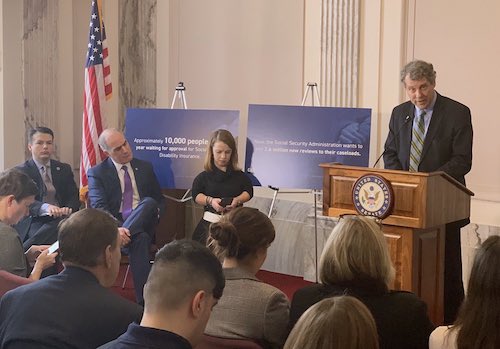A federal scheme that could rob millions of injured workers of their Social Security Disability Insurance is being widely condemned as a vicious attack on vulnerable Americans, similar to disastrous cuts in the 1980s.

|
| At a Jan. 28 news conference on Capitol Hill, Sen. Sherrod Brown speaks out against a proposed rule that threatens Social Security disability benefits for more than 2 million ill and injured workers. Other speakers included, at left, Rep. Brendan Boyle and Sen. Robert Casey, who circulated letters signed by more than 160 lawmakers urging the Social Security Administration to drop the proposal. Photo courtesy of Rebecca Vallas, Center for American Progress.
|
“There’s no reason to do this other than cruelty and mean-spiritedness,” U.S. Sen. Sherrod Brown said at a Jan. 28 news conference. “It won’t save money.”
The Social Security Administration plan calls for revisiting many disabled workers’ cases more often, a process opponents say is cumbersome and unjust and almost always requires legal counsel that low-income working families can’t afford.
The proposal set a record for public comments about a Social Security rule change, with more than 125,000 people speaking out on the Federal Register by the end of the comment period Jan. 31.
The same week, 41 senators signed a letter to Social Security Commissioner Andrew Saul detailing the ways the agency failed provide adequate data, evidence or a cost-benefit analysis to support its plan.
“SSA’s proposed rule to change when and how the agency conducts CDRs (continuing disability reviews) is unjustified and arbitrary,” the letter states. Millions of Americans – including many IBEW members and retirees – would be required “to reprove their eligibility for benefits more frequently without reason, placing significant additional burden on individuals and families that are already stretched thin.”
Further, the plan’s $1.8 billion price tag “would be better directed toward shortening still unacceptably long disability application wait times and eliminating the disability hearing backlog.”
Altering the disability review process had tragic consequences during the Reagan administration in the early 1980s. It caused such a bipartisan uproar that a bill to undo the harm passed 99-0 in the Senate and 402-0 in the House.
“Close to a half million on disability received termination notices at that time,” Philadelphia Legal Aid lawyer Jonathan Stein said at the January news conference. “The newspapers were filled with horror stories of suicides, of people on around-the-clock oxygen, people with cerebral palsy who were terminated in these reviews. It caused devastation in the lives of hundreds of thousands of people.”
Opponents say few, if any, countries make it harder for disabled workers to receive benefits than the United States, where an understaffed system and byzantine process of paperwork and hearings typically lead to years of delays.
Ultimately, most applicants are rejected. The most recent Social Security data shows that two-thirds of applicants were denied between 2007 and 2017.
Denial doesn’t mean a person isn’t disabled, advocates stress. Many applicants can’t afford attorneys, and can’t navigate the system without one. Legal Aid and pro-bono lawyers are overwhelmed.
“They don’t tell you up front that you need legal representation,” said an IBEW journeyman wireman who spent four years fighting for benefits in his late 50s, after disabling back and leg pain forced him to leave the career he loved. He spent his retirement savings to stay afloat before finally being approved in 2019.
The Electrical Worker is withholding his name to protect him from any backlash in the event of a review. “It’s a nightmare, the whole thing is,” he said. “The problem is that they act like it’s not your own money, when you’ve been paying into it your entire working life.”
Social Security projects that 2.6 million people out of 8.5 million on disability would be subject to early reviews over the next 10 years. Between new criteria and a process already full of landmines, watchdogs expect that most of the beneficiaries affected will be dropped.
“They want to add these reviews to a workload that will make SSA wait time even worse, and it will cost them almost $2 billion to do it,” Sen. Robert Casey said at the Jan. 28 event. “It is wrong, it is a mistake, and it’s certainly not in the interests of justice.”
The plan is also targeting 600,000 low-income adults and children who receive Social Security Insurance, aid for non-working people with disabilities. SSI’s monthly payments are their lifeline, advocacy groups say, even though the maximum benefit still leaves them well below the poverty line.
The assaults on SSDI and SSI are separate from recent threats to Social Security, Medicare and Medicaid issued by President Trump and GOP lawmakers itching to revive a 2016 bill that called for program cuts, means testing and raising the retirement age from 67 to 69. Senate Majority Leader Mitch McConnell falsely claims the programs are the “real drivers” of the record $23.2 trillion national debt.
“The president is saying he would be open and welcome cuts to Social Security in his second term,” Congressman Brendan Boyle said at the news conference. “Some of my colleagues in the House aren’t even waiting. They have already introduced legislation. Sen. McConnell has given remarks that it was his great, unfinished business to cut Social Security.”
Brown said the latest blitz of attacks is right out of the “corporate crowd’s playbook.”
“It’s always the special interests’ plan – drive deficits up
with tax cuts and then come after people with disabilities, come after the
elderly, come after low-income people,” the longtime labor ally said. “Cut and
cut and cut, whether it’s taking Social Security money from Americans with
disabilities or block-granting Medicaid or forcing nurses and construction
workers and others to work until they’re 70.”